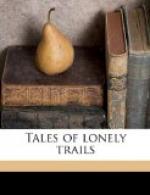TALES OF LONELY TRAILS
CHAPTER I
NONNEZOSHE
John Wetherill, one of the famous Wetherill brothers and trader at Kayenta, Arizona, is the man who discovered Nonnezoshe, which is probably the most beautiful and wonderful natural phenomenon in the world. Wetherill owes the credit to his wife, who, through her influence with the Indians finally after years succeeded in getting the secret of the great bridge.
After three trips to Marsh Pass and Kayenta with my old guide, Al Doyle of Flagstaff, I finally succeeded in getting Wetherill to take me in to Nonnezoshe. This was in the spring of 1913 and my party was the second one, not scientific, to make the trip. Later this same year Wetherill took in the Roosevelt party and after that the Kolb brothers. It is a safe thing to say that this trip is one of the most beautiful in the West. It is a hard one and not for everybody. There is no guide except Wetherill, who knows how to get there. And after Doyle and I came out we admitted that we would not care to try to return over our back trail. We doubted if we could find the way. This is the only place I have ever visited which I am not sure I could find again alone.
My trip to Nonnezoshe gave me the opportunity to see also Monument Valley, and the mysterious and labyrinthine Canyon Segi with its great prehistoric cliff-dwellings.
The desert beyond Kayenta spread out impressively, bare red flats and plains of sage leading to the rugged vividly-colored and wind-sculptured sandstone heights typical of the Painted Desert of Arizona. Laguna Creek, at that season, became flooded after every thunderstorm; and it was a treacherous red-mired quicksand where I convinced myself we would have stuck forever had it not been for Wetherill’s Navajos.
We rode all day, for the most part closed in by ridges and bluffs, so that no extended view was possible. It was hot, too, and the sand blew and the dust rose. Travel in northern Arizona is never easy, and this grew harder and steeper. There was one long slope of heavy sand that I made sure would prove too much for Wetherill’s pack mules. But they surmounted it apparently less breathless than I was. Toward sunset a storm gathered ahead of us to the north with a promise of cooling and sultry air.
At length we turned into a long canyon with straight rugged red walls, and a sandy floor with quite a perceptible ascent. It appeared endless. Far ahead I could see the black storm-clouds; and by and bye began to hear the rumble of thunder. Darkness had overtaken us by the time we had reached the head of this canyon; and my first sight of Monument Valley came with a dazzling flash of lightning. It revealed a vast valley, a strange world of colossal shafts and buttes of rock, magnificently sculptored, standing isolated and aloof, dark, weird, lonely. When the sheet lightning flared across the sky showing the monuments silhouetted black against that strange horizon the effect was marvelously beautiful. I watched until the storm died away.




